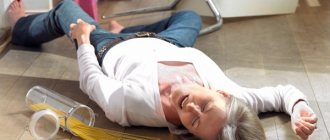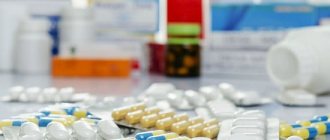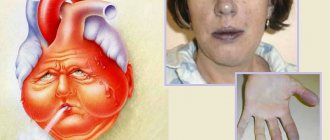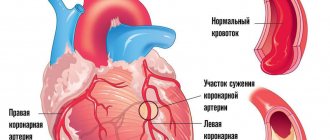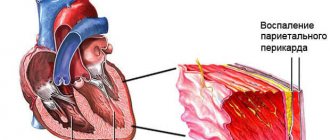Angina pectoris is one of the common diseases that is diagnosed mainly in older and older people. The main symptom of angina is the appearance of pain or discomfort in the central part of the chest, therefore its second name is the term “angina pectoris”.
The etiology of angina pectoris is quite diverse, but most often the development of the disease is provoked by a narrowing of the vascular lumens, which supply the heart with blood. Most often, this disorder occurs in atherosclerosis, when cholesterol deposits accumulate on the internal surfaces of veins and arteries, which, in turn, disrupts their normal blood flow. An attack of angina occurs suddenly, so it is important to know how to help the patient and what medications can be taken to eliminate it.
Nature of pain
It is the pain syndrome and signs of the disease that help identify angina pectoris in men
and prescribe adequate treatment. The patient during an attack of angina experiences a feeling of squeezing and constriction deep behind the sternum, and not on the surface. Numbness or discomfort in the arms, most often localized in the left limb or shoulder blade. The patient may feel discomfort in the neck, lower jaw or teeth. Pain during angina pectoris is specific, manifests itself in the form of an attack, that is, it is possible to determine the beginning and end of the pain syndrome.
Signs of angina and its difference from other diseases
Clinical picture
Angina pectoris manifests itself:
- moderate pain in the chest or behind the sternum;
- pressing, squeezing pain (cutting or burning more indicate a heart attack);
- nausea;
- instability of heart rhythm;
- respiratory dysfunction;
- panic.
Since the signs of angina are very similar to the manifestations of panic attacks, you need to first calm down and not immediately diagnose yourself with cardiac dysfunction. Along with this, it is necessary to clarify the diagnosis with a therapist, or better yet, with a cardioneurologist.
Symptoms of an attack
An attack of the disease usually lasts from one to fifteen minutes. In this case, the patient feels a compressive pain on the left behind the chest, varying in intensity. The attack may be accompanied by a feeling of fear, nausea, profuse sweating, lack of air and dizziness. After the paroxysmal pain passes, the patient feels weak and tired.
There are nocturnal attacks of angina pectoris; they are characterized by such symptoms as lack of air and irregular pulse. The patient begins to choke during such an attack.
If a patient feels that an angina attack lasts more than 20 minutes, it is imperative to consult a cardiologist. Frequent and prolonged manifestations of the disease can lead to myocardial infarction.
What are the symptoms of angina pectoris?
Severe pain in the heart is a reason to be wary. It is possible that this is angina pectoris, the symptoms of which will indicate the likelihood of an even more dangerous heart disease - coronary heart disease. And such a situation indicates a lack of oxygen, which all other organs will experience.
Insufficient nutrition of the heart muscle will most often occur as a result of a decrease in the lumen of the arteries. This is due to the plaques formed on their walls. Here, an analogy with the scale that appears in a kettle would be successful. Plaques occur due to a number of factors. Everything is simple here: when such atherosclerosis affects not small vessels, but important coronary arteries, then myocardial ischemia manifests itself. And angina is its symptom. How to correctly diagnose this disease?
Symptoms
Typical signs:
- jump in blood pressure;
- squeezing, pressing pain in the depths behind the sternum;
- burning sensations;
- labored breathing;
- pain radiating to the left shoulder and arm;
- loss of sensitivity in hands.
Atypical symptoms:
- pain syndrome localized in the lower jaw, cervical region, back;
- feelings of weakness;
- pale skin;
- chills and increased sweating;
- disturbances of heart rhythm and pulse;
- feeling of heartburn;
- vomiting, nausea;
- discomfort in the intestines.
What should emergency care be like?
Should you call an ambulance if a person suffers from these symptoms? You will definitely need to do this in a number of the following cases:
- This is the first time a person has experienced such symptoms.
- The pain gets worse and will continue for more than five minutes. At the same time, it is accompanied by a significant deterioration in breathing, as well as vomiting and weakness.
- The pain does not stop even after the nitroglycerin tablet is dissolved.
However, even before the ambulance arrives, a number of measures will need to be taken:
- Make the person sit down with their legs down. He should not be allowed to get up.
- Give an aspirin tablet to chew.
- To relieve pain, you can suggest placing one nitroglycerin tablet or isoket in a special aerosol package under the tongue.
- If these measures do not help, you will need to repeat them: nitroglycerin after three minutes, and isoket after a minute. You need to remember that you can take such drugs no more than three times - there is a risk of lowering blood pressure.
Stable angina
In this category of disease, the symptoms are persistent in nature.
They occur most often after physical activity. Localization is retrosternal. The duration of the attack ranges from one to fifteen minutes, and is of an increasing nature. It goes away when you stop exercising and the patient takes nitroglycerin. Symptoms of stable angina in men may also include shortness of breath and fatigue during high exertion. This disease is easily diagnosed and responds well to treatment.
Stable and unstable angina
In this type of angina, the walls of the blood vessels are narrowed to such an extent that similar attacks will occur both during work and during rest. Different degrees of severity made it possible to carry out the following gradation into classes:
- In the first case, pain rarely occurs. Most often they appear with increasing load.
- In the second functional class, they can develop in the case of rapid climbing uphill, up stairs. Sometimes this happens in the wind and even after a heavy meal.
- Signs of the third class already indicate further limitation of activity. In this case, pain may appear even when the patient is simply walking. And of course, any physical work can be accompanied by the appearance of such attacks.
- The fourth class defines a great limitation in activity. In this case, the person is no longer able to perform even light work without developing similar symptoms of the disease. This will happen even without a certain load.
In the case when a habitually ongoing disease suddenly begins to manifest itself differently, it can lead to a pre-infarction state. Doctors call it unstable and define it by the following changes:
- If the last specified disease manifests itself in the first ten days after a heart attack, then a post-infarction symptom can be claimed.
- Characteristic is angina at rest - that is, a condition when attacks pass in complete rest.
- The frequency of attacks suddenly increases. They are heavier and take longer to complete. It often happens that such phenomena occur at night.
- The patient first experienced angina syndrome no more than a month ago.
Any of the above signs is an urgent reason for hospitalization. Moreover, the referral should definitely go to the intensive care unit.
Another name for this disease is vasospastic. In variant angina, symptoms may occur after a sudden spasm of the arteries. It is no exception when the arteries may not be affected by wall plaques. It can occur at rest, in the morning, and at night. You should also pay attention to the duration of the attack: it will last no more than 5 minutes.
Unstable angina
Patients with signs of unstable angina should be immediately hospitalized and placed under intensive monitoring and treatment. This type of heart disease is dangerous for the development of myocardial infarction. Cardiologists distinguish several subtypes of unstable angina:
- first appeared;
- progressive, increased pain, manifestation of an attack even at rest, shortness of breath;
- post-infarction, occurs after the development of myocardial infarction after 24 hours to 8 weeks.
Types of pathology
Depending on the cause of occurrence, the disease is divided into:
- angina pectoris, which occurs as a result of exposure to physical activity on the body;
- angina at rest, in which attacks occur in the patient without any reason during sleep or in a lying position.
Another name for angina at rest is unstable angina. With this disease, pain that appears at rest is characterized by a longer duration, the appearance of shortness of breath and a feeling of inadequate rest. Angina at rest is one of the forms of manifestation of coronary heart disease and the main cause of its development is atherosclerotic plaques that clog the coronary arteries.
This condition leads to impaired blood circulation and the result is a disruption in the supply of oxygen and nutrients to the heart muscle. Most often, rest angina develops with severe damage to the coronary arteries and is a severe form of motion angina.
Attacks of the disease occur at rest and usually occur in women during menopause, and in men after 40 years. A symptom of resting angina is an attack, which is often accompanied by fear, profuse sweating and panic attacks. Painful sensations are pronounced and can be accompanied by a burning and pressing sensation. Angina at rest requires mandatory diagnosis and the prescription of a specific course of treatment.
First aid for an attack of illness
If an attack occurs during physical activity, you must stop immediately. Lie down or take a comfortable position. Unbutton tight clothes, open the window, the flow of fresh air will make breathing easier. If the patient already has medicine prescribed by the doctor, he should take it. It is better to start with minimal doses, wait 5 minutes and if the signs of angina have not gone away, take another dose. Taking the maximum dose of the medicine at once may cause addiction.
Nitroglycerin will also help relieve signs of the disease, but it should be used with great caution. It should be given to a patient only if you are sure that the person really has heart problems. One of the side effects of nitroglycerin is a sharp decrease in blood pressure. Do not give the drug to a patient who is faint or unconscious. In this situation, you must immediately call an ambulance.
Timely referral of the patient to a cardiologist, taking measures to prevent angina pectoris, proper treatment are the path to successful recovery.
Diagnostics
The survey of a patient with signs of angina is brief, but includes the main questions - when the pain appeared (at rest or after exercise), whether there have been recent stressful situations, a single attack or there have been other episodes, what medications are being taken, the presence of diagnosed diseases.
Next, a clinical, biochemical (especially if you are overweight or over 40 years old) blood test and an electrocardiogram are prescribed. If these methods are not enough to make a diagnosis, then they may resort to assessing blood glucose, cardiac ultrasound and computed tomography.
Symptoms of angina pectoris in males
Of course, the manifestation of pathology in men is somewhat different from the symptoms noted by women. The reason is not that a man’s heart hurts differently or that the signs are not as pronounced. It’s just that men do not attach importance to pain in the early stages, ignoring them. A visit to a doctor occurs already when angina passes into a pre-infarction state.
Among men, the pathology is much more likely to lead to death, which is caused by untimely visits to a cardiologist.
In the early stages, men describe a mild pain that is localized behind the sternum and can radiate to the jaw, arm or neck. Sometimes there are no painful sensations at all, and the attack is characterized by rapid heartbeat, pallor, and increased blood pressure.
Most often, the pain goes away suddenly if the triggering factor is eliminated. So, it is enough to stop playing sports for the attack to end. But dyspeptic manifestations, such as nausea, vomiting, discomfort in the intestinal area, are extremely rare in men.
The progression of angina also affects male sexual function, which can be reduced even in young people. The disease affects people over the age of 30, although the older generation complains of cardiac disorders much more often.
Features in men
In men, along with the typical signs of angina pectoris, atypical symptoms may also develop. In particular, they are characterized by the appearance of an abdominal variant of an attack of ischemia and myocardial infarction. This creates:
- painful sensations in the epigastric region, which resemble heartburn in nature;
- belching, nausea, vomiting;
- dyspepsia.
Due to the fact that men who experience similar symptoms believe that they have worsened gastritis or an ulcer, they do not consult a doctor in a timely manner. A registered ECG helps make a diagnosis, so this study is included in the list of mandatory tests for all hospital patients. In this case, the risk of developing myocardial infarction of the lower wall increases significantly. It is this localization of the heart attack that is due to the fact that in this area the heart is adjacent to the diaphragm and stomach. In this regard, there are common nerve connections, and ischemic damage to the myocardium is perceived by the body as a stomach disease.
In addition, men with diabetes may experience painless attacks of angina pectoris, which are accompanied by general weakness and malaise, but there is no typical pain syndrome. In this case, signs of damage to the heart muscle can only be detected on an ECG. This is due to the fact that the sensitivity of nerve receptors decreases against the background of high glucose levels, so myocardial ischemia is practically asymptomatic. This type of angina also often leads to the development of heart attack, which requires immediate treatment in a hospital.
Another variant of the atypical course of myocardial infarction in men is asthmatic. This course of angina is associated with the development of edema of the bronchial wall and difficulty breathing. In this case, cardiac asthma develops, which cannot always be distinguished from bronchial asthma. Typically, an attack of shortness of breath occurs when walking, when breathing cold air, and also during stress. To distinguish angina pectoris, an ECG should be done during an attack. With the ischemic variant, some characteristic signs are usually found.
In general, men are much more likely to suffer from angina, so if there are any signs that even remotely resemble coronary heart damage, additional testing should be done, such as an ECG.
Characteristics of the disease
Angina pectoris is a disease that is a form of coronary heart disease and manifests itself in the form of periodic attacks.
The development of angina is indicated by the occurrence of severe pain in the chest area, which cannot be eliminated with the help of cardiac medications.
The etiology of the disease is quite diverse, but the main provoking factor is the narrowing of the lumen in the vessels that supply blood to the heart. As a rule, such a disorder occurs with the development of atherosclerosis, when cholesterol deposits accumulate on the internal surfaces of veins and arteries, preventing normal blood flow.
Insufficient blood supply to the heart is the main cause of angina.
Adverse factors that can provoke the appearance of pathology also include:
- overweight;
- nicotine addiction;
- alcohol abuse;
- heavy physical activity;
- frequent exposure to stress;
- diabetes;
- hypertension.
Due to the nature of the causes of angina pectoris, men are predominantly at risk for developing the disease. Elderly women also suffer from this disease, but much less frequently, due to the action of hormones that act as a protective barrier.
How does pathology progress in representatives of the stronger sex and by what signs can it be recognized?
Treatment of angina
If an attack of angina occurs, first aid should be provided, and this must be done competently so as not to cause harm. First of all, you need to sit the person down and provide him with access to fresh air, give a Nitroglycerin tablet under the tongue if the form is stable, and 2-3 tablets with an interval of 2-3 minutes if the form is unstable. Then give an Aspirin tablet to chew.
A doctor should treat angina after diagnosis. Self-medication in this case can lead to very serious and undesirable consequences. As a rule, the following groups of drugs are prescribed:
- Nitrates are antispasmodics.
- Beta blockers - reduce the myocardial oxygen demand.
- Thrombolytics are blood thinners.
- ACE inhibitors – lower blood pressure.
- Statins – improve blood cholesterol levels.
Which medications the patient should take and according to what regimen is decided only by the attending physician. The success of treatment largely depends on the patient himself. First of all, you need to urgently change your lifestyle:
- switch to a low-calorie diet, lose weight;
- give up bad habits - do not drink alcohol and quit smoking;
- avoid excessive physical exertion, but do feasible health-improving exercises;
- exclude sauna and steam procedures.
Treatment and prevention of the disease
Angina is one of the diseases that cannot be completely cured. The risk of myocardial infarction and death is constantly high.
A system of preventive measures and timely treatment under the supervision of a doctor will help control the course of the disease, reduce the frequency of symptoms, reduce the risk of complications, and increase working capacity.
The first aid for an attack is nitroglycerin. Those suffering from the disease must always have it with them in order to stop the attack in time.
In a medical institution, drug treatment includes taking anti-ischemic, anti-sclerotic drugs, long-acting nitrates, etc. Sometimes surgical intervention is indicated.
Preventive measures include:
- weight loss through diet;
exercise therapy;- walks in the fresh air at a calm pace for at least 2 hours a day;
- blood pressure control;
- avoiding factors that can cause stress;
- dispensary control;
- treatment of concomitant diseases;
- full sleep of at least 8 hours.
Timely consultation with a doctor and following the recommendations allows you to achieve a state of long-term remission.
Author of the article:
Elena Demidova
about the author
Did you like the article?
Let us know about it -
rate
Signs of angina in women
Angina pectoris in women is characterized by a milder course than in men.
The peculiarity of angina pectoris in women is that the development of the disease is possible even with practically normal coronary vessels and this seriously complicates the diagnosis. During an attack, vasospasm occurs, which in a calm state does not indicate the presence of the disease. In addition, the pain is neurological in nature. There are also difficulties in the informativeness of diagnostic methods, in particular, a test with physical activity, which allows one to completely detect angina pectoris in men, is often false in women.
Otherwise, the signs of angina in women are completely identical to those that appear in men, but may not be as pronounced.
The cause of the disease, which distinguishes female angina from male angina, is the onset of menopause, as well as after surgery to remove the ovaries.
